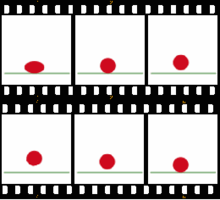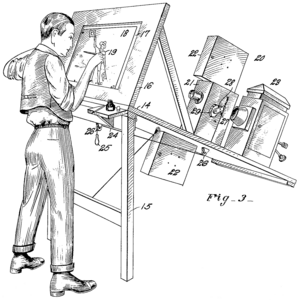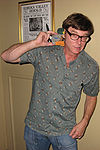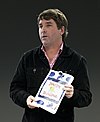
| Main | Categories and topics | Tasks and projects |
Introduction
Animation is a filmmaking technique by which still images are manipulated to create moving images. In traditional animation, images are drawn or painted by hand on transparent celluloid sheets (cels) to be photographed and exhibited on film. Animation has been recognized as an artistic medium, specifically within the entertainment industry. Many animations are computer animations made with computer-generated imagery (CGI). Stop motion animation, in particular claymation, has continued to exist alongside these other forms.
Animation is contrasted with live-action film, although the two do not exist in isolation. Many moviemakers have produced films that are a hybrid of the two. As CGI increasingly approximates photographic imagery, filmmakers can easily composite 3D animations into their film rather than using practical effects for showy visual effects (VFX). (Full article...)
Selected article
Atlantis: The Lost Empire is the first science fiction film in Disney's animated features canon and the 41st overall. Set in 1914, the film tells the story of a young man who gains possession of a sacred book, which he believes will guide him and a crew of adventurers to the lost city of Atlantis. Linguist Marc Okrand created an Atlantean language for the film (letter "A" pictured). Atlantis made greater use of computer-generated imagery than any of Disney's previous animated features; it remains one of the few to have been shot in anamorphic format. Atlantis, which adopted the distinctive visual style of comic book creator Mike Mignola, is one of the few Disney animated features not to have songs. The film premiered at the El Capitan Theatre in Hollywood, California, on June 3, 2001, and went into general release on June 15. Due to the film's poorer-than-expected box-office performance, Disney quietly canceled both a spin-off television series and an underwater attraction at its Disneyland theme park. Some critics praised it as a unique departure from typical Disney animated features, while others disliked it due to the unclear target audience and absence of songs.
Selected image
Did you know (auto-generated) -

- ... that Paul Dini was a writer for both the animated television series Batman: The Animated Series and the video game series Batman: Arkham?
- ... that, for the animated film Us Again, director and writer Zach Parrish considered a video of an elderly couple dancing to be visceral and ideal inspiration?
- ... that the first lady of the Ivory Coast created an animated kids' show in 1989?
- ... that the Tuca & Bertie episode "The Jelly Lakes" employs a paper-cutout animation that helps to depict abuse in a way that centers the victim's story?
- ... that at age 12, Shaylee Mansfield became the first deaf actor to be credited alongside the voice actors for a signed performance in an animated production?
- ... that Encanto's Isabela Madrigal was animated to be aware that she is "always on stage"?
Selected quote
Selected biography
Stephen Hillenburg (1961–2018) was an American cartoonist, animator, and former marine biologist. He is the creator of the Nickelodeon television series SpongeBob SquarePants (1999–), which he has also directed, produced, and written. It has gone on to become one of the longest-running American television series as well as the highest-rated show ever to air on Nickelodeon. Born in Lawton, Oklahoma and raised in Anaheim, California, Hillenburg became fascinated with the ocean as a child and developed an interest in art. He started his professional career in 1984, instructing marine biology, at the Orange County Marine Institute, where he wrote The Intertidal Zone, an informative comic book about tide-pool animals, which he used to educate his students. He was later offered a job on the Nickelodeon animated television series Rocko's Modern Life (1993–1996) after his success with short films The Green Beret and Wormholes (both 1992), which he made while studying animation. Besides his two Emmy Awards and six Annie Awards for SpongeBob SquarePants, Hillenburg has also received other recognition, such as an accolade from Heal the Bay for his efforts on elevating marine life awareness, and the Television Animation Award from the National Cartoonists Society.
Selected list
The first season of the animated comedy series Family Guy aired on Fox from January 31, 1999, to May 16, 1999, and consisted of seven episodes. The series also aired on Fox Family on January 5, 2000 to February 16, 2000. The show features the voices of series creator Seth MacFarlane (pictured), Alex Borstein, Seth Green, and Lacey Chabert in the roles of the Griffin family. The executive producers for the first season were David Zuckerman and MacFarlane. The series premiere, "Death Has a Shadow", was broadcast directly after Super Bowl XXXIII and was watched by 22.01 million viewers. The series received praise from most critics, particularly "I Never Met the Dead Man" and "Brian: Portrait of a Dog". However some critics disliked the themes of the episodes. The Volume One DVD box set, including all seven episodes and the second season, was released in Region 1 on April 15, 2003, Region 2 on November 12, 2001 and Region 4 on October 20, 2003. The series has since been released in syndication.
More did you know...
- ...that the first Filipino full-length animated film, Adarna, was created by Gerry Garcia in the late 1990s?
- ...that American voice actors "kept slipping into a Jamaican accent" when voicing Malaysian characters in Kampung Boy?
- ...that Bruce Timm, the producer of the animated film adaptation Batman: Year One, said that adapting the comic story arc was straightforward since the original story was already cinematic?
Anniversaries for October 6
- Films released
- 1934 - The Miller's Daughter (United States)
- 1950 - Quick on the Vigor (United States)
- 1951 - Nit-Witty Kitty (United States)
- 1951 - Ballot Box Bunny (United States)
- 1968 - Tickled Pink (United States)
- Television series and specials
- 1985 - Jem and the Holograms, an American animated television series begins airing in syndication
- 2002 - Captain Tsubasa: Road to 2002, a Japanese anime televesion series finishes airing on TV Tokyo
- 2004 - Yu-Gi-Oh! GX, a Japanese anime television series begins airing on TV Tokyo
Subportals
Related portals
Wikimedia
The following Wikimedia Foundation sister projects provide more on this subject:
-
Commons
Free media repository -
Wikibooks
Free textbooks and manuals -
Wikidata
Free knowledge base -
Wikinews
Free-content news -
Wikiquote
Collection of quotations -
Wikisource
Free-content library -
Wikiversity
Free learning tools -
Wiktionary
Dictionary and thesaurus

























